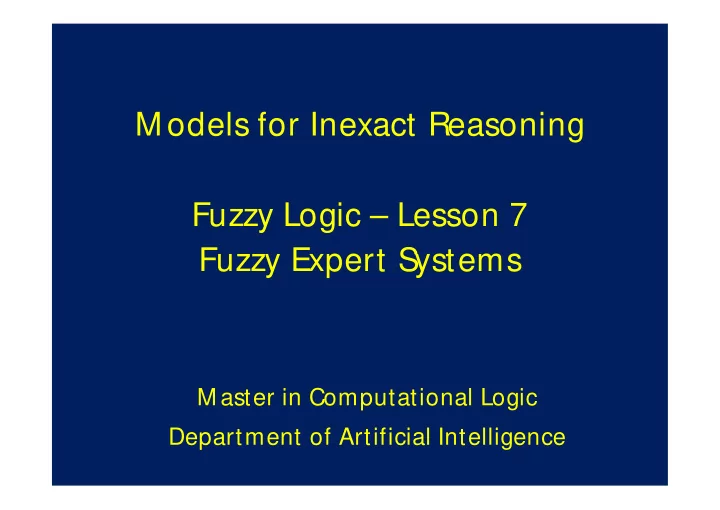

M odels for Inexact Reasoning Fuzzy Logic – Lesson 7 Fuzzy Expert Systems M aster in Computational Logic Department of Artificial Intelligence
Expert Systems • Computer-based systems that emulate the reasoning process of a human expert • Different purposes: – Consulting – Diagnosis – Learning – Decision support – Designing, planning, etc.
Architecture of an Expert System
The Knowledge Base • The KB, aka long-term memory, contains general knowledge belonging to the domain of interest • Knowledge normally represented as (fuzzy) production rules – Connect antecedents with consequents, premises with conclusions or conditions with actions – M ost common form: “ IF A THEN B” (being A and B fuzzy sets)
The Facts Database • Also known as short-term memory or blackboard interface • Contains the current state (facts) • It is updated after the firing of production rules – Previous state � Rule firing � Current state • Previous facts are removed and the memory is updated with the current facts
The Inference Engine • Operates on a series of production rules and makes fuzzy inferences. Approaches: – Data driven: supported by the generalized M P • The ES uses supplied data to evaluate relevant production rules and draw conclusions – Goal driven: exemplified by the generalized M T • The ES search for data specified in the IF clauses that will lead to the objective • These data can be found either in – The KB – THEN clauses of other production rules – Querying the user
M eta-Knowledge Base • The FES may use knowledge regarding the production rules in the KB • This includes meta-rules regarding: – Stopping criteria – Preconditions to fire determined rules – Whether a fact should be inferred or requested from the user • Purpose: facilitate computation pruning unneccessary paths
Explanatory Interface • Facilitates communication between the user and the expert system • Enables the user to determine how the ES obtained intermediate of final conclusions – Or why specific information is being requested from the user • Crucial for building user confidence in the system • Useful for identification of errors, omissions, inconsistencies, etc.
Knowledge Acquisition M odule • Included only in some expert systems • M akes it possible to update the KB or the metaknowledge base through interaction with experts • M ust implement suitable algorithms for machine learning (Socratic learning or example-based learning) – Artificial Neural Networks – Genetic Algorithms, etc.
Expert System Shell • If the domain knowledge domain is removed from the ES, the remaining structure is a “shell” • An inference engine embedded in an appropriate shell is reusable for different domains • Examples of non-fuzzy and fuzzy shells – Prolog Expert System Shell (PESS) – Java Expert System Shell (JESS) – Fuzzy Prolog
Design of the Inference Engine • When designing the fuzzy inference engine we have to consider the following: – Determine the type of inference engine • Data-driven (forward chaining) • Goal-driven (backward chaining) – Select a suitable fuzzy implication • Determine whether or not the M P or M T are required and choose an appropriate implication – M P is normally required for forward chaining – M T is normally required for backward chaining
M ulti-Conditional Reasoning • Fuzzy Expert S ystems make use of approximate, multi-conditional reasoning: Rule 1: If X is A 1 , then Y is B 1 Rule 2: If X is A 2 , then Y is B 2 .....… … … … … … … … … … … … … … … … … Rule N: If X is A n , then Y is B n Fact: X is A’ ============================= Conclusion: Y is B’
The Interpolation M ethod • M ethod for multi-conditional reasoning • Step 1: Calculate the degree of consistency between the given fact and the antecedent of each rule ( ) ( ) ( ) ( ) ( ) µ = µ ∩ µ = µ µ r h min sup min x , x j A ' A ' A A ' A = j j we take T ∈ x X • Step 2: Calculate the conclusion by truncating each B j to the value r j ( µ A’ ) and take the union of the truncated sets ( ) ( ) ( ) ( ) µ = µ µ y sup min r , y B ' j A ' B { } j ∈ j 1, K , n
The Interpolation M ethod (Example)
Recommend
More recommend